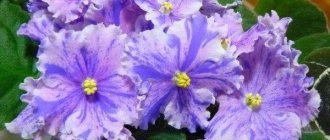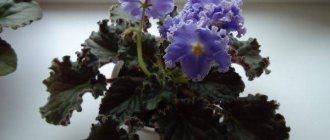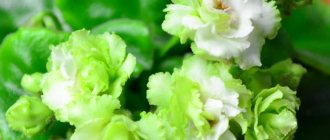Recommendations for planting and care
The great advantage of Lebetskaya violets is their unpretentiousness in flower care. If the bush is grown correctly, problems may not arise at all.
What type of soil does he like, lighting, degree of moisture, planting container?
To properly grow violets, it is necessary to create favorable conditions indoors, as well as plant the flower in nutritious soil. The optimal temperature for keeping is 20-26 ℃. You should beware of drafts, as the plant does not respond well to temperature fluctuations.
For maintenance, it is necessary to select places with diffused light so that the plant does not get burned. With a lack of light, flowering will not be abundant. The soil is regularly fed with mineral fertilizers. To do this, use superphosphate and carry out the procedure twice a month.
Water the bush once a week so as not to flood it, otherwise the soil will compact and become unusable. After watering, the soil is loosened to a depth of 3-4 centimeters.
Important! To grow, you need to select neutral soil; in acidic soil, the flowers of the bush will begin to dry out and turn pale.
The main difficulties in caring for a plant
There are no serious difficulties in growing. The main thing is not to flood the bush and monitor the lighting. When water stagnates in the soil, pests and infectious diseases can appear.
Basic rules for aftercare
It’s not for nothing that they talk about the ease of caring for Saintpaulias.
Create conditions for them similar to their relatives: Choose a comfortable place: Well lit, but not under the scorching sun. They even need to be shaded from direct rays. Blinds, curtains and mosquito nets; Eastern and western window sills are often used by flower growers; In winter, they also provide lighting
Phytolamps are recommended to be used; It is important to be under the light for 10-12 hours.
Moderate soil moisture:
Water very carefully. Settled water at room temperature; Every other day at high temperatures
The condition of the soil and humidity will tell you everything. Maybe 2 times a week will be enough; Much less often in winter. Typically once a week; This is where experience matters a lot. And constant monitoring of soil conditions. But flooding is dangerous for the plant.
Very important! Avoid getting sockets wet. Water the violet along the sides of the pot
Or from a pallet.
- Maintain the required temperature and humidity;
- Only after 2-3 weeks can you feed: In the initial stage, more nitrogen. For the plant to gain strength;
- Potassium and phosphorus should predominate during bud formation and flowering;
- Carefully study the composition of purchased mineral fertilizers for violets.
And all this should be observed especially punctually after transplanting blooming violets.
Free the plant from drafts and spraying. And sudden temperature changes.
Problems during cultivation
Bullfight violet: description of the variety, photo, cultivation features
Since the Magenta violet is a capricious plant, any incorrect action regarding the regime can cause problems.
The main difficulties and their solutions are listed below:
- Crushed inflorescences - overheating. Move the plant to a cooler place.
- The foliage has faded - there is a draft. Provide the plant with safe ventilation and keep it in a place protected from temperature changes.
- Growth has slowed down, there is no flowering - lack of nutrients. Fertilize on time, alternate organic complexes with mineral ones.
- The appearance of rot spots on leaves and stems (fusarium) is a sharp drop in temperature. During the rest period, the temperature is reduced gradually, by several degrees (temperature below +16 ° C is critical). The second reason is humidity. It is necessary to monitor the watering rate.
- Brown dry spots on the foliage are signs of burns. South windows should have a protective film or curtain.
- Powdery mildew (white spots on green parts) - high humidity. Do not over-water the flower. Use watering methods recommended for the variety. Fungal diseases (fusarium, powdery mildew) can be prevented by spraying with a solution of potassium permanganate once a month. Flowers are difficult to treat: the delicate foliage does not withstand spraying with fungicides. Remedy: after treatment for medicinal purposes, transplant to a new location.
Then the bush is treated with green soap (10 g/1 l of water). After water procedures, the foliage should be thoroughly blotted with a napkin.
Saintpaulia Magenta is loved by gardeners for its large and bright flowers. You can achieve flowering by following the care rules and providing the plant with the necessary microclimate.
Possible problems and difficulties
When replanting a blooming violet, they only count on a positive result:
- They do it in accordance with the recommendations;
- They use their experience in growing and transplanting;
- Create the necessary conditions for violets.
And if the transplant was incorrect, there will be undesirable consequences. And the outcome is far from expected. You will see this for yourself. By her appearance. The plant grows slowly. Or stands still:
Check the temperature and humidity in the room. Low temperatures and dry air cannot in any way promote the growth of violets. Frequent transplants do not always give good results;
Lack of good lighting in winter. It will be difficult to wait for flowering; You may have made a mistake with the location for the transplanted plant. Possible sunburn (brown spots)
If it is under the sun's rays;
Improper watering can cause diseases rather than good growth and flowering; Use different fertilizers very carefully; Avoid frequent changes in the location of the flower.
Reproduction
Summer twilight violet: variety description, planting and care
Theoretically, Saintpaulia Magenta can be propagated by seeds and the vegetative method. In practice, only the second method is used in home gardening. If propagated vegetatively, then two options are applicable: by dividing the bush and by leaf.
Dividing the bush is used when the plant has flowered.
The division technology is as follows:
- The bush is carefully dumped out of the container, and the baby is separated with a sharp knife.
- The delenka is planted in a small pot, up to 6 cm in diameter, and covered with something, forming something like a greenhouse.
- Ventilate and water in small portions daily.
- The mother bush is freed from dry parts and transplanted into a new pot.
The requirements for it are:
- the sheet should not be old and not from the lowest row;
- absence of signs of disease on the material (suspicious spots, burn marks);
- the cutting must be healthy, and the plate must be elastic and dense.
Further sequence of actions:
- The cuttings are cut at an acute angle of 45°.
- Root in boiled water, adding activated carbon, which will prevent rotting.
- After roots 1–1.5 cm long appear, the leaf cuttings are transplanted into the ground.
- Bury the cutting into the soil no more than 1 cm, and if necessary, provide a support for the leaf.
- Further care is the same as for an adult plant.
Did you know? South Germanic tribes celebrated the first day of spring when the first violet was found. And the find promised a profitable marriage and prosperity in family life to the lucky one.
How Saintpaulia Cuff propagates
Violet Frosty cherry - description and characteristics of the variety
The described plant reproduces in two ways: seeds and vegetatively.
The “older” the violet, the darker and more saturated the color of the inflorescences becomes
The second method is more often used at home. This method involves dividing the bush into two or three parts or cutting off the leaves, followed by rooting.
The technology of vegetative propagation by dividing the bush is carried out in several stages:
- The bush is carefully removed from the pot.
- Gardeners use a sharpened knife to separate the “baby”.
- The separated particle is placed in a small pot (no more than 6 cm in diameter).
- The flowerpot is covered with a glass container or lid, forming a greenhouse.
- Ventilation and watering with small portions of water are carried out daily.
For reference! The method of propagation by seeds is used exclusively by breeders. Le Magenta violet seeds are suitable for breeding new varieties.
The mother bush must be cleared of dried parts and transplanted into a new vessel.
Transplantation from the mother plant
Evergreen Meyer lemon: description, plant care, reproduction, diseases and pests
The mother plant helps children and stepchildren gain useful elements for future independent life.
Stepchildren must reach a certain height and gain at least 3 leaves in order to separate from the mother plant.
As soon as all proportions are maintained, the young animals must be separated for further development.
Deadlines
In variegated violets, the babies appear in a light shade. They can be replanted into a separate pot when the leaves have gained enough green pigment. An early landing will lead to their death.
The best time for replanting is summer or autumn, when there is still plenty of daylight.
In winter, growth stops and the plant will sit for a long time without signs of growth. To speed up growth, additional lighting and warmth are installed.
Technology
The separation occurs as follows:
- The offspring, together with the maternal element (leaf, fragment, peduncle), is pulled out of the pot. Freed from the earth;
- The shoots are carefully separated from each other so as not to damage the fragile root system. Small children can be left for further growth with the mother plant;
- Each shoot must have its own root system;
- If the stepson appears in the axils of the leaves, it is separated with a toothpick. In this case, there is no root system, and the stepson is sent into the ground to form a root.
Separation of the baby from the mother plant.
Seating process
The offspring are pulled out of the pot. They are freed from the ground and separated from each other by hand. Prepare the soil, baking powder, drainage, and pots.
All children are seated in separate containers.
Features of soil and container selection
The soil for young pets should be loose. Buy ready-made soil for violets in specialized stores.
Perlite or vermiculite will help increase breathability. Lay the bottom with expanded clay or foam.
The diameter of the first pot should be 3 cm. So that the soil does not become sour and the plant does not die.
The stepson is placed in vermiculite soil.
How to properly bury a violet in the ground
A hole is made in the soil, and the shoot is carefully placed and the roots are straightened. Another layer of moist, but not wet, soil is poured on top.
The growing point should be above the soil level. This is done to prevent moisture from getting into the outlet when watering.
Aftercare
The nuances of how to care for violet babies:
- the air temperature should be between 22-24 degrees C;
- Watering is done with warm, settled water in small portions. Repeated watering is done after the top layer has completely dried;
- a pot with a young plant is placed in a bag or covered with a transparent lid. For example, from under a cake. The flower is left under cover for 3-4 weeks;
Children in the greenhouse.
- as soon as new leaves appear, it means that Saintpaulia has taken root. Gradually teach your teenager to walk without shelter. Only then remove the bag;
- choose a window sill on the north-west or north-east side.
Disease Prevention
Preventive actions and proper care will help you avoid the disease:
- using old pots will lead to bacterial diseases, so treat them with boiling water and disinfectants;
- overwatering can cause the formation of rot;
- hypothermia threatens rotting of the root system and the development of infectious diseases;
- water getting on the leaves leads to the formation of gray rot, botrytis.
Varieties and types of garden violets
The most popular of the perennials is the horned violet
( Viola cornuta)
, with flowers 3-5 cm in diameter, from lilac to dark purple with a small yellow eye, blooming from May to September. There are many varieties, the most famous:
Alba
- white flowers;
Coconut
- white, with dark strokes on the lower petals;
Underland
light purple;
Atona
– creamy yellow;
Belmont Blue
- blue;
Scottish Yellow
- golden yellow;
Purple Duet
- lower petals are dark pink with dark strokes, upper petals are burgundy;
Plum Velvet
- purple-violet with a small light eye;
Yellow Prince
- yellow, miniature variety, height 15 cm.
The well-known Wittrock violet.
or pansy (
V. x wittrockiana
large flowers up to 10 cm in diameter, grown as a biennial, has many varieties and variety series.
Majestic Giants
have the largest flowers
Rococo
has petals with scalloped edges;
Velur Mixed
is a dwarf variety.
And the hybrid Williams violet
(V.
x williamsii)
with flowers up to 3 cm in diameter, there are ampelous varieties.
Fragrant violet
(V.
odorata)
with small and very fragrant flowers blooms in April-May.
The most popular varieties: Christmas
- white flowers;
Rosina
- pink, very fragrant.
Czar
- purple, very fragrant;
Red Charm
- purple;
Charlotte
- dark purple.
- profusely blooming Altai violet
(V.
altaica Ker- Gawl) -
flowers up to 3 cm in diameter, blue-violet with a yellow spot, white or cream with blue stripes on the lower petals, blooms from the end of April for 40-45 days, again - from August before the snow; - yellow violet ( V. lutea)
- flowers 1.5-3.0 cm in diameter, yellow, with dark strokes on the lower petals, blooms in May-July; - dog violet
(V.
site)
- height up to 30 cm, flowers up to 2.5 cm in diameter, blue, whitish in the throat, blooms in May-June; - miniature Labrador violet ( V. labradorica)
with purple flowers is distinguished by a purple hue of leaves, blooms in May-June, variety
Purpurea
- purple flowers with a white spot in the center; - moth violet,
or
hooded violet ( V. papilionacea Pursh
-
V. cucullata),
blooms from April to June, the
Priceana
has bluish-purple flowers with a white border and a yellow eye,
Red Giant
has violet-red flowers;
Freckles
are white with numerous small purple speckles.
The graceful violet
( V. gracilis)
is distinguished by its long flowering - from spring to autumn
Lord Nelson
variety has dark purple, almost black flowers;
Major - purple with a yellow eye; Moonlight
- yellow.
Watering rules dictated by Amadeus
Violet is important in matters of hydration. She does not like excessive humidity, drying out of the soil surface, or getting water on rosettes, leaves and flowers, since all plant tissues are vulnerable and quickly rot. Therefore, gardeners recommend watering using the “in a tray” method. It is carried out like this: a container with a violet is placed in a tray half filled with water, kept for 20-30 minutes, and the remaining moisture must be removed, since stagnation of water will not allow the roots to breathe fully.
Saintpaulias are not sprayed, but they maintain a fairly high air humidity, which is achieved by installing containers with wet pebbles next to the plant or household humidifiers. The leaves of the plant also need care. Periodically they are wiped with a soft flannel slightly moistened with water, removing dust and giving the violet the opportunity to fully breathe and successfully form.
How to prepare seeds before planting
It is recommended to start planting violets with seeds early in spring or late in winter. For breeding, it is worth buying special containers with drainage holes. The latter serve to eliminate excess soil moisture. You can use commercially available universal primer. Although you can choose a special one for violets.
Seeds can be used within two years. This time they are able to retain their growth properties.
After the container is filled with soil, it is moistened using a spray bottle. Seed distribution is ensured evenly throughout the container. Before sowing, it is better to grind the seeds with sand in a small amount. This will eliminate the light oily layer. They will germinate faster.
Then everything is covered with a small layer of soil or vermiculite. Then the container must be placed in a plastic bag and tied tightly. Place in a warm place. After some time, you will be able to see the first viola sprouts.
Story
There is one interesting moment hidden in the history of this species. As you know, violets were first mentioned in the myths of the ancient period. But the problem is that the plant from ancient Greek mythology and what is now generally called violets are two different biological species. "Violets" (Saintpaulias) were discovered in the mountains of eastern Africa at the end of the 19th century. They were found by the commandant of the German colony, Walter von Saint-Paul (the culture was named after him).
The scientific description of the plant and the first production of flowering seedlings are the merit of the botanist Hermann Wendland. Saintpaulia was introduced into mass circulation surprisingly quickly. It was found in 1892, and already in 1893 it appeared at an exhibition and immediately captivated flower growers. Nothing strange: a representative of the Gesneriaceae family, called the Usambara violet, looks very beautiful. The definition of “Uzambar” is associated with the name of the mountain range near which wild Saintpaulia was first discovered.
The word "violet" came about because of the clear resemblance to real violets (which were quickly relegated to the background). In 1893, the fame of Saintpaulia was already resounding throughout Europe, and in 1894, American flower growers became acquainted with it. Very soon, it was in the New World that a key center for the selection of modern violets would be formed. The next significant date for Uzambara violets is 1898. It was then that breeders were able to develop plants with pink, white and burgundy flowers.
In the 1920s, one of the Californian companies managed to switch from propagating Saintpaulia from seeds to leaf propagation. This immediately simplified the work and made it much more productive. In a matter of years, it is possible to replenish the assortment with more than ten promising varieties. As a result, a real “violet boom” begins. A number of clubs are being created to breed this flower.
In 1938, backlight technology became public. Proper use of it has made it possible to grow plants with previously unattainable flower sizes in temperate climates. Many varieties that are still popular today were created between 1940 and 1970. It was then that the world became acquainted with corrugated and fringed petals, with a star-shaped flower. New properties and possibilities of violet (as we will now call it uniformly, starting from universal practice) were constantly revealed.
What does violet Raisin look like?
The Raisin variety belongs to the Violet genus and the Violet family. There are more than 600 species of this plant in the world, but even against their background, Raisin can surprise.
Violet Raisin with variegated flowers
Violet Raisin or DS-Raisin has a very memorable appearance due to its unusual inflorescences.
The compact bush has a height of 30-40 centimeters. The leaf blades grow directly from the basal rosette and have a teardrop shape. Their surface is smooth, and the color is solid dark green without inclusions or light areas or veins.
Violet DS Raisin was developed by crossing varieties found at the end of the 19th century by a British baron who traveled to East Africa. Breeders made many different hybrids of these flowers in the mid-20th century, the most beautiful of which was the DS Raisin violet.
This is interesting! Among some plant lovers there is an opinion that in Latin violet is written as “violet”. In fact, this is not so - in the West they are called Saintpaulia (Latin: Saintpaulia).
What is sport among fantasy saintpaulias?
You can often hear the term “violet sport”, what does this mean? There is nothing complicated in this word; this is how they designate varieties that, over a long period of cultivation, have managed to lose the properties and characteristics of their ancestor variety. As a rule, such flowers can already be called a new subspecies of violets.
Leaf sport
Leaf blades may undergo noticeable changes in shape and color. This is influenced by the conditions under which the bush is kept, the method of its propagation, the quality of fertilizing and the pH level of the soil.
Sport of flowers
Violet sport suffers noticeable changes in the characteristics of its flowers. Due to genetic mutations and the effects of certain external factors, the color and shape of the inflorescences can completely change. Raisin's ancestors had a solid lilac color, and the current plant has left this external resemblance to a small extent.
Violet Magenta
The flower is held in this position until the top layer of soil darkens. Next, the pot is removed from the water and placed on a tray to remove excess moisture.
The drip method consists of watering the plant directly under the root and is done using a large syringe or watering can with a long and narrow spout. Water in such a way that the growing point and leaves remain dry. This method is the least labor-intensive and is widely used by flower growers.
The wick method is as follows: a rope made of natural fibers is passed through the drainage hole of the pot, and its opposite end is placed in a container of water. This method allows the root system to take in exactly as much water as it needs.
❻
Fertilizers are applied to moist soil immediately after watering. Ready-made mineral violet magenta photo and description of the variety, specially designed for Saintpaulias, are used as fertilizers. Before applying fertilizers, you should carefully read the instructions for reading more of the drug and in no case exceed the dosage. Transplantation Violets are replanted once a year in the spring before the onset of hot weather.
This magenta violet photo and description of the variety is the most favorable for two reasons: the plant has already come out of a dormant state when it could not be touched; Before budding, and even more so before flowering, there is still enough time during which the flower will have the opportunity to adapt after transplantation.
❻
The process of transplanting violets occurs step by step. A 3 cm layer of expanded clay is placed at the bottom of the pot, on top of which a mixture prepared from peat is poured.
Then the magenta violet photo and description of the violet variety are placed in the center and the voids are gradually filled with substrate. The next day, the plant is watered, after which it is transferred to normal care. It is not recommended to water the flower on the day of transplantation.
❻
This is due to the fact that the roots could be damaged, and they need at least a day for the wounds to heal. Otherwise, the process of rotting of the damaged roots may begin, and the magenta violet photo and description of the variety will die. The most common diseases are fusarium and powdery mildew. Treatment of these diseases is complicated by the fact that violets cannot be sprayed, since the tender leaves of the plants die after such a procedure. Therefore, it is easier to prevent a disease than to treat it later.
❻
Thus, the appearance of putrefactive spots of fusarium is caused by a sharp drop in temperature due to excessive watering. Powdery mildew, the first sign of which is the appearance of white spots, is also the result of excess moisture. Both diseases are fungal and appear as a result of improper care. As for pests, apart from the whitefly invasion, https://mystroyrus.ru/what-are-breeds-of-pigeons-photos no longer causes problems for the violet.
If white flies do attack the plant, then adult flies are caught by hand, after which the leaves are treated with a solution of green soap 10 g per 1 liter of water and thoroughly blotted with a napkin.
❻
Transplantation after purchase and during reproduction
Professional gardeners recommend transplanting the violet to a new “place of residence” immediately after purchase. The best time to replant is before the summer heat. This period is explained by two reasons:
- The plant has emerged from “sleep”, when any manipulation is strictly prohibited.
- There is still plenty of time before flowering.
- Possible quick adaptation to a new place.
The transplant is carried out step by step:
- A three-centimeter expanded clay layer is laid out on the bottom of the container.
- Prepared soil is poured on top of it. The pot is filled one third full.
- The future bush is located in the center.
- The voids are filled with soil.
After replanting, be sure to water the flowerpot. And then - transfer to the usual care regimen.
Features of caring for Le Magenta violet at home
In order for a flower to delight its owners with lush inflorescences, bright colors and constant growth, appropriate care is necessary. In this regard, Saintpaulia Magenta has certain features.
Temperature
The optimal temperature range is +18-25 degrees Celsius. At low temperatures, the plant rots; at elevated temperatures, it leads to the formation of aphids.
To avoid problems in winter, it is recommended to place a 3-centimeter layer of insulation under the pot on the northern window sill (the simplest option is polystyrene foam).
We must not forget about ventilation: fresh air is the key to successful germination.
Lighting
Here the situation is this: bright light is needed, but direct sunlight is prohibited. Aggressive exposure to the sun leads to burns of the leaves, so you should resort to diffused lighting.
Additional Information! During short daylight hours, additional illumination through artificial lamps is needed.
While it is winter, the flowerpot feels calm on the south side.
Features of violet care at home
However, with the arrival of hot weather, it is better to move the Le Magenta violet to an eastern or western windowsill.
Feeding
It is recommended to feed the plant with useful substances twice a month. While violets have a dormant period (November-February), the amount of fertilizing should be reduced to once every 40-50 days.
On a note! Good examples of fertilizers are products under the Stimovit, Baikal, and Master brands.
Fertilizers are applied to pre-moistened soil (certainly after watering). They use complexes of minerals.
Watering, spraying and humidity
The moisture level in the air should reach 55-65%. Lack of humidity can be solved in two ways:
- spraying the space around the pot;
- humidifier.
The water should be at room temperature - within 22-24 degrees.
There are three watering methods:
- Lower. A deep vessel is needed here. Fill the taken container with water and place the pot with violets at ¾ of the height. Darkening of the top layer indicates that the soil is saturated with moisture.
- Drip. A syringe or watering can with a narrow nose is used. The soil is watered without touching the growing point and leaves.
- Wick. One end of a piece of natural fiber rope passes through the drainage hole in the pot, the other is lowered into a container of water. So, the roots will take only the amount of liquid that is necessary for growth.
Watering is an important component of care. The procedure is carried out as the soil dries. The main thing is to make sure that the soil is not flooded or completely dry.
Priming
Magenta violet grows well in special purchased soil or in a homemade substrate. In order to “prepare” a suitable soil, you need to mix four ingredients in equal proportions:
- peat;
- crushed sphagnum moss;
- leaf soil;
- humus.
Terry leaves and a bright violet flower captured in macro photography
The resulting mixture is thoroughly mixed through a strainer.
Attention! The soil must be calcined before use. This is done in the oven at 100-200 degrees for thirty minutes. This removes small debris, the remains of some roots and breaks up the formed lumps
The resulting combination is loose and soft, with no foreign elements or unwanted organic residues
This removes small debris, the remains of some roots and breaks up the formed lumps. The resulting combination is loose and soft, with no foreign elements or unwanted organic residues.
Description
To decide on the choice of variety, you need to read the description of the appearance of the Uzambara violet variety.
Leaves
Large leaf blades are located on long petioles and have a pointed end of the leaf. The underside of the leaf plate is silver. As the sheet plate ages, the underside may turn pinkish. The size of the rosette is 15 cm, but it is not dense.
Flowers
Very large, double-shaped flowers have a red-burgundy hue with a strongly corrugated border, on which there is an interrupted white border.
The flowers have a beautiful deep color.
Flowering is long from the first time and continues for 60 days.
The diameter of a single opened bud is up to 5 cm.
The flower itself is located on a long peduncle, the peduncle is quite thick, because of this they seem to lie a little on the leaf plates under the weight of their petals.
Features and differences from other varieties
A special feature of the variety is that as the bush ages, the border located along the edge of the petals will increase, and the red color will change to a dark burgundy hue.
The Magenta variety is demanding on the amount of diffused sunlight and therefore it must be provided with a well-lit place, but without direct sunlight.
Growing rules
The rules for caring for the RS-Duchess violet are practically no different from those of other varieties.
Important indicators for obtaining a healthy, actively flowering plant are the place where the flower grows, the ambient temperature, lighting, and the correct method of watering.
Selecting a location
The best place for violets to grow is considered to be a window sill.
This is where she will receive enough light.
At the same time, it is important to protect the plant both from overheating in summer and from hypothermia of the roots in winter. Moving the flower deep into the room to a shaded place will save you from overheating.
If there is no suitable place in the room, it is important to maintain high air humidity around the flower so that the leaves evaporate less moisture from the inside, and monitor the condition of the soil
Moving the flower deep into the room to a shaded place will save you from overheating.
If there is no suitable place in the room, it is important to maintain high air humidity around the flower so that the leaves evaporate less moisture from the inside, and monitor the condition of the soil
As you know, soil dries out faster in hot weather.
Some gardeners have found an interesting solution to the problem of growing violets in the summer. Fans are directed at the shelves with violets.
The use of fans allows you to reduce the temperature around the flower and prevent the formation of fungal diseases, since high humidity with little air movement is an ideal condition for the growth of mycelium.
In very intense heat, to save the violet, you can take extreme measures and tear off all the buds. This measure will allow the plant not to waste energy on flowering.
There are two ways to protect the plant from hypothermia:
- The violet pot is placed in a larger pot. In this case, a thermos effect occurs - the air between the walls of the pots does not allow the cold to penetrate into the soil to the roots.
- Styrofoam is placed under the bottom of the pot. This will insulate its lower part, which will benefit the root system.
Choosing a pot
It is usually recommended to plant violets in a pot whose diameter is three times smaller than the diameter of the rosette of leaves.
As a result, for flowering, an adult violet is planted in a pot with a diameter of 7-9 cm.
This condition does not apply to the Duchess. In a small pot, the plant withers and the leaves turn yellow.
The ideal pot for a young violet is a pot with a diameter of 9-13 cm. However, using a larger diameter is unacceptable - this will cause increased growth of green mass and will cause the flowering to stop.
Soil selection
It is best to collect soil for violets in a coniferous forest. It is this soil that contains the most beneficial substances for violets. It is not recommended to take soil from the garden and vegetable garden, since pests are most often present in it.
Before pouring the soil into the pot, it must be thoroughly calcined in the oven - this will kill harmful bacteria. Violet will feel best in soil pre-fertilized with phosphorus and potassium.
If it is not possible to collect soil from the forest, you can purchase planting substrate at a flower shop.
Along with it, you must also purchase drainage, which is poured onto the bottom of the pot to avoid the accumulation of unnecessary moisture in the lower part of the pot.
Watering
PC-Duchess is a variety with a large rosette. Most often, the leaves extend beyond the edge of the pot and obscure the soil.
The center of the rosette is most often thickened.
This is why watering from above will have a negative effect on the violet. Over-watered leaves will quickly wither when in contact with the ground.
In addition, such watering will cause the development of fungal diseases and the appearance of insect pests.
Watering in trays is best for the Duchess
It is important not to leave water for more than 15 minutes, making sure that the soil is moistened to the required extent
Temperature
The Duchess is highly dependent on the ambient temperature. Sudden changes will harm the color of the petals, and the violet as a whole will lose its decorative appearance.
According to the observations of flower growers, the Duchess feels best at a temperature of +20°C, growing in a northern window. However, you shouldn’t play around with cool temperatures - you won’t be able to achieve flowering in a cold room.
Drafts also have a detrimental effect on this variety of violets.
At high temperatures, flowers become sluggish. It will not be possible to achieve the formation of rosettes.
Feeding
Fertilizers for violets can be purchased at any flower shop.
When using, it is important to follow the instructions for use - an excess of mineral components can harm the plant more than their absence
How to choose
When choosing miniature violets, like any other indoor flowers, you should be guided by your own idea of beauty. All other criteria are far-fetched. Mini violets are practically no different from their relatives, classic Saintpaulias, except for their truly small sizes. Some parts of the flower are difficult to see without optical instruments.
Most varieties of miniature Saintpaulias were bred with the participation of Russian botanist Igor Milekhin. What goals he pursued when breeding half-mini and mini violets is unknown, but he fully managed to preserve the beauty of Saintpaulias, reducing their size, because the diameter of adult miniature violets does not exceed twenty centimeters, and almost all Saintpaulias of non-standard size are associated with the name of Igor Milekhin.
Conventionally small flowers and semi-mini Saintpaulias can be divided into:
- Microminiatures with a rosette diameter of up to 60 millimeters;
- Miniatures with a rosette up to 150 millimeters in diameter;
- Semi-miniatures with a flower diameter of up to 200 mm.
Each of these varieties, despite the apparent similarity with their larger counterparts, requires certain knowledge, patience and skill when courting and breeding. But miniature violets will delight their owners with bright flowers of unusual sizes.
Popular articles Rose Olivia Rose (Olivia rose) - description of varietal shrubFeatures of home care
Double violets generally require the same care as other members of the violet genus. The biggest whim of terry ones is strict adherence to the light regime.
Content Basics
It is recommended to keep double violets indoors or in greenhouses with air humidity maintained at least 60-80%. At the same time, do not forget about:
Preventive measures against pests
To avoid infection by harmful insects, it is necessary to regularly spray and wipe the leaves. Also, it is necessary to periodically replant the flower and get rid of it from limp leaves and dry inflorescences.
Classification
All varieties of double violets can be divided into groups according to several criteria. For example, depending on the degree of terryness, two main groups are distinguished:
- Terry;
- Semi-double.
In the photo you can see a terry violet. Also, there is a division into groups, depending on the appearance of the Saintpaulia inflorescence:
- Pectinate;
- Carnation.
According to color scheme they are distinguished:
- Light terry violets;
- Dark terry varieties.
IMPORTANT! Violets of several colors conditionally form separate groups of double Gesnerievs. The first includes Saintpaulias of red, pink and raspberry varieties
The second is formed by plants with blue, blue and lilac flowering.
Among the light representatives of terry, in particular, the following varieties are distinguished:
- Atlantis;
- Bridal bouquet;
- Lyubasha;
- And also several others.
Dark Saintpaulias are adequately represented by the varieties Chateau Brion and Gift for a Beloved.
Most often, on the windowsills of avid flower growers, you can see Saintpaulias with a simple type of terry. These plants differ from all other types:
- Leaf shape (round soft leaves of dark green color);
- And also the structure of the flower of the plant.
In representatives of the genus with a simple type of terry, the corolla consists of 4-6 petals.
Flowers with the so-called comb degree of doubleness usually have at least 6 petals in the corolla of the flower. More often, the number of petals of such a plant can be at least 8-9 pieces.
One of the most famous scallops is the Gift for a Beloved variety. It is also distinguished from other terry varieties by the shape of its petals. The fact is that in plants with this type of terry, the top of the flower has a wavy shape with a fringe on top of the flower.
Semi-double flowers are recognizable:
- By the shape and color of the leaves (round or oval, velvety, light green);
- And also by the number of petals in a flowering rosette (from 6 to 9).
In turn, terry Saintpaulias have 10 or more petals in a flower rosette.
As for the degree of terryness like carnations, such varieties have an incompletely opened rosette with semi-double petals.
ATTENTION! The shape of the flowers of such violets resembles carnation flowers, hence their name.
Reminder for a newbie!
Uzambara (Uzumbar) violet is a plant of the Gesneriaceae family, growing in the natural environment of tropical and subtropical regions of Asia, Africa, Eastern Australia, South America and the Indian Ocean islands.
Saintpaulia is a plant named after the Saint-Paul father and son, who brought a plant unknown to Europeans from the Uzambara district (modern Tanzania) in the 19th century, presented for the first time at the international flower exhibition in Ghent in 1893.
Indoor violet has been one of the most popular plants in indoor floriculture since 1927. By 1949, more than 100 varieties had been bred, and today their number exceeds several thousand.
Rooting
- possibly in water, in substrate, moss.
Priming
- purchased soil or a mixture of leaf, coniferous, turf and peat soil in a ratio of 3:1:2:1 with the addition of raising agents (perlite, vermiculite, river sand, crushed sphagnum moss.
Lighting - it is best to place flower pots on western or eastern windows. To ensure that the plant is evenly illuminated from all sides, the pots are periodically rotated. In winter, when daylight hours decrease, you can use artificial lighting - fluorescent lamps.
Caring is a real art and serious painstaking work at the same time, including watering, fertilizing, and creating a favorable humid climate. Water Saintpaulias as the soil dries. The soil must be moistened regularly, but excess moisture should not stagnate in the roots. When watering, you must ensure that water does not get on the leaves. You cannot water the Uzambara violet with cold water. Fertilizing is done with complex mineral fertilizer once every two weeks. Saintpaulia reacts negatively to a lack of nitrogen in the soil. Optimal air humidity is approximately 50%, temperature is 20-22 ° C, without sudden fluctuations and drafts. The leaves of the plant should not touch the window glass. Removal of faded flowers and damaged leaves is carried out regularly.
Reproduction - planting a leaf cutting, part of a leaf, or a daughter rosette. The most popular method is rooting leaf cuttings. The formation of roots and the development of children lasts 4-8 weeks.
Pests are one of the gardener's problems. There are many different types of pests and it is very difficult to classify them. Among Saintpaulia pests, several groups can be distinguished: mites (spider mites, flat mites, transparent mites, etc.), insects (aphids, thrips, springtails, poduras, scale insects, whiteflies, scale insects, etc.), worms (nematodes).
Diseases - distinguish between infectious (gray rot, powdery mildew) and non-infectious diseases (rotting of the stem and root, wilting of the lower leaves, yellowing, leaf spotting, incomplete opening and premature drying, falling of flowers) of plants. The causative agents of infectious diseases are bacteria, fungi, and viruses. To prevent infectious diseases, you should strictly observe the regimes of watering, temperature, humidity, and lighting. Non-communicable diseases usually arise due to poor agricultural practices. They may appear in one instance and not spread to others.
{SOURCE}
Popular varieties of indoor violets (with photos)
As a rule, the name of popular violet varieties comes from the name of the breeder who created a new masterpiece. Sometimes other names are chosen that more clearly describe the main qualities of the new plant variety.
EK-Nautilus. The variety was bred by Elena Korshunova. Unpretentious for cultivation. It has large semi-double blue-white flowers with blue stripes running from the center with wavy petals.
LE-Rings of Saturn. Large flowers of a rich lilac hue with darker streaks along the edges of the petals, in the center and scattered. Care is standard and does not require special attention.
AB-Caramels. Type - semi-miniature, semi-double or terry. The flowers are white with purple or crimson wide stripes. Externally very impressive, does not require special care.
Balchug Avenir. The view is semi-miniature. The flower shape is classic, the color is two-tone - blue stripes on a pink background. A very delicate flower, absolutely unpretentious.
Spring Rose (Spring Rose). Beautiful double violet with snow-white flowers of a greenish tint. Characterized by abundant flowering. Standard care.
Ma's Southern Springtime. The view is semi-miniature. The peculiarity is very abundant flowering with a lush cap. The flowers are semi-double white with an asymmetrical crimson spread. Growing is standard.
Blue watercolor. A very beautiful, but at the same time unpretentious and fast-growing variety. It has snow-white double flowers with unequally spaced purple strokes.
RS-God of the Sun. A beautiful bright variety. It has large double cherry flowers with a white edge. It blooms earlier than other species, blooms profusely and for a long time.
Perfect Harmony. A recently bred, but already popular variety, it belongs to the fantasy species. The flowers are of a standard size, very bright in color - on a blue background with pink splashes and a white edging around the edge. It blooms profusely, but, like fantasy, requires special attention.
Stormy Weather. Another fantasy variety. The flowers are large, rich blue with blue splashes. Without proper care, it will lose its variegated color.
Hot Spot. Large semi-double red flowers with ruffled edges. It is characterized by abundant flowering, fast growth and ease of cultivation.
Silver Romance. A multi-color variety that absolutely everyone likes because of its remarkably beautiful color. It has soft pink flowers, a richer shade towards the center and lighter towards the edge. The edge requires a separate discussion, because it is decorated in the form of light green ruffles. The leaves are dark green with a wavy edge.
LE-Polina.
The species is gigantic, the flowers are also very large, multi-colored, rich in lilac color with blue splashes and white corrugated fringe along the edge.
Victorian Ribbons. The species is a chimera. It has a very rich base purple hue with wide stripes of white that radiate out in a star shape from the center. Very stable peduncles, abundant flowering. Requires special attention, like all chimeras.
It is difficult to cover all the variety of varieties available in a nutshell. You can also list a lot of beauties such as Snow Edelweiss, New Year's Snow, Podvenechnaya, Jan-Tornado, PC-Sea Princess, FantasyMakers and so on.
But the surest way to come into contact with this beauty is to go to the nearest flower shop and invite the fashionista Saintpaulia to your home.
And for those who like to know more, we suggest that you familiarize yourself with a visual video guide about the varieties of violets.
Selection of Elena Lebedskaya
Lebetskaya’s violets appeared by chance; the woman collected various types of flowers. Soon she began seriously creating new varieties based on standard varieties. This group now includes varieties with different shapes, sizes and structure of leaves, as well as many colors of buds. Already known all over the world.
Double and colorful Le violets bred by one breeder
Brief biography of the breeder
Elena Anatolyevna Lebetskaya was born and currently lives in the Ukrainian city of Vinnitsa. She has her own country house on the outskirts, which is convenient for her type of activity. The woman began collecting violets and sectioning them seriously in 2000. By 2022, there are already more than 400 varieties of Le violets.
Advances in breeding
At the moment, all the flowers selected by Elena Lebetskaya are extremely popular all over the world. A well-known variety is Lyon's Early Spring, whose distinctive feature is large snow-white buds. This flower is the only white violet in the world.
Over the course of her 20-year career, Lebetskaya has received many awards and prizes not only within the CIS countries, but also at international festivals and exhibitions. The breeder actively cooperates with the Moscow House of Violets and continues to create new varieties.
When and how does it bloom
Violet Raisin - description and characteristics of the variety
Violet Cuff begins to bloom in March. First, the plant throws out long stalks, at the ends of which there are from 3 to 5 baskets. Semi-double and double flowers of rich red color appear from them. Their diameter is 5 cm. There is a white border along the edge of the petal.
The flowering period takes 55-65 days











